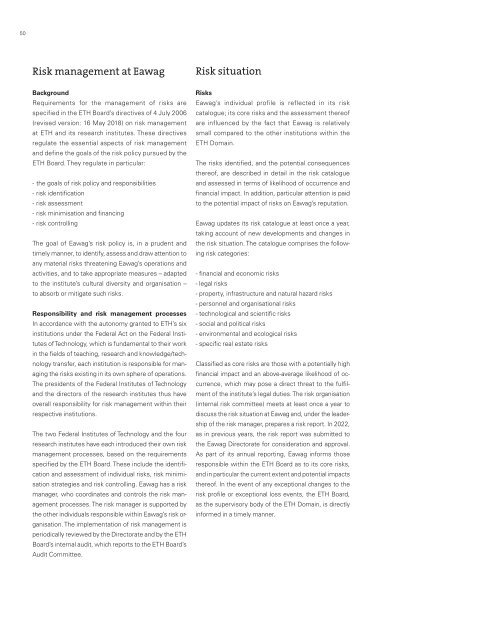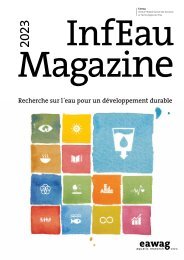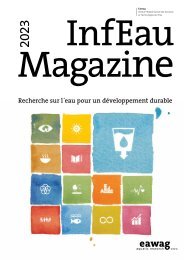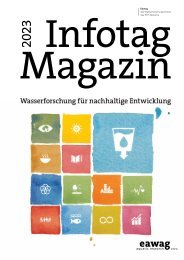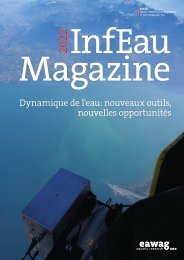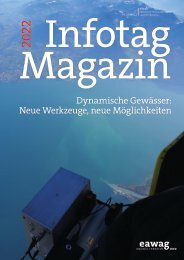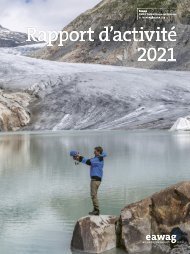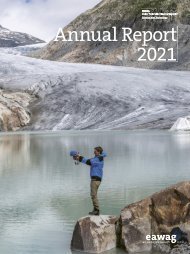Eawag Annual Report 2022
As the aquatic research institute of the ETH Domain, our research is in service of society. You can see this for yourself in our Annual Report. The annual compact review highlights the most relevant research results of the past year and shows how they were developed.
As the aquatic research institute of the ETH Domain, our research is in service of society. You can see this for yourself in our Annual Report. The annual compact review highlights the most relevant research results of the past year and shows how they were developed.
Create successful ePaper yourself
Turn your PDF publications into a flip-book with our unique Google optimized e-Paper software.
50<br />
Risk management at <strong>Eawag</strong><br />
Risk situation<br />
Background<br />
Requirements for the management of risks are<br />
specified in the ETH Board’s directives of 4 July 2006<br />
(revised version: 16 May 2018) on risk management<br />
at ETH and its research institutes. These directives<br />
regulate the essential aspects of risk management<br />
and define the goals of the risk policy pursued by the<br />
ETH Board. They regulate in particular:<br />
- the goals of risk policy and responsibilities<br />
- risk identification<br />
- risk assessment<br />
- risk minimisation and financing<br />
- risk controlling<br />
The goal of <strong>Eawag</strong>’s risk policy is, in a prudent and<br />
timely manner, to identify, assess and draw attention to<br />
any material risks threatening <strong>Eawag</strong>’s operations and<br />
activities, and to take appropriate measures – adapted<br />
to the institute’s cultural diversity and organisation –<br />
to absorb or mitigate such risks.<br />
Responsibility and risk management processes<br />
In accordance with the autonomy granted to ETH’s six<br />
institutions under the Federal Act on the Federal Institutes<br />
of Technology, which is fundamental to their work<br />
in the fields of teaching, research and knowledge/technology<br />
transfer, each institution is responsible for managing<br />
the risks existing in its own sphere of operations.<br />
The presidents of the Federal Institutes of Technology<br />
and the directors of the research institutes thus have<br />
overall responsibility for risk management within their<br />
respective institutions.<br />
The two Federal Institutes of Technology and the four<br />
research institutes have each introduced their own risk<br />
management processes, based on the requirements<br />
specified by the ETH Board. These include the identification<br />
and assessment of individual risks, risk minimisation<br />
strategies and risk controlling. <strong>Eawag</strong> has a risk<br />
manager, who coordinates and controls the risk management<br />
processes. The risk manager is supported by<br />
the other individuals responsible within <strong>Eawag</strong>’s risk organisation.<br />
The implementation of risk management is<br />
periodically reviewed by the Directorate and by the ETH<br />
Board’s internal audit, which reports to the ETH Board’s<br />
Audit Committee.<br />
Risks<br />
<strong>Eawag</strong>’s individual profile is reflected in its risk<br />
catalogue; its core risks and the assessment thereof<br />
are influenced by the fact that <strong>Eawag</strong> is relatively<br />
small compared to the other institutions within the<br />
ETH Domain.<br />
The risks identified, and the potential consequences<br />
thereof, are described in detail in the risk catalogue<br />
and assessed in terms of likelihood of occurrence and<br />
financial impact. In addition, particular attention is paid<br />
to the potential impact of risks on <strong>Eawag</strong>’s reputation.<br />
<strong>Eawag</strong> updates its risk catalogue at least once a year,<br />
taking account of new developments and changes in<br />
the risk situation. The catalogue comprises the following<br />
risk categories:<br />
- financial and economic risks<br />
- legal risks<br />
- property, infrastructure and natural hazard risks<br />
- personnel and organisational risks<br />
- technological and scientific risks<br />
- social and political risks<br />
- environmental and ecological risks<br />
- specific real estate risks<br />
Classified as core risks are those with a potentially high<br />
financial impact and an above-average likelihood of occurrence,<br />
which may pose a direct threat to the fulfilment<br />
of the institute’s legal duties. The risk organisation<br />
(internal risk committee) meets at least once a year to<br />
discuss the risk situation at <strong>Eawag</strong> and, under the leadership<br />
of the risk manager, prepares a risk report. In <strong>2022</strong>,<br />
as in previous years, the risk report was submitted to<br />
the <strong>Eawag</strong> Directorate for consideration and approval.<br />
As part of its annual reporting, <strong>Eawag</strong> informs those<br />
responsible within the ETH Board as to its core risks,<br />
and in particular the current extent and potential impacts<br />
thereof. In the event of any exceptional changes to the<br />
risk profile or exceptional loss events, the ETH Board,<br />
as the supervisory body of the ETH Domain, is directly<br />
informed in a timely manner.


